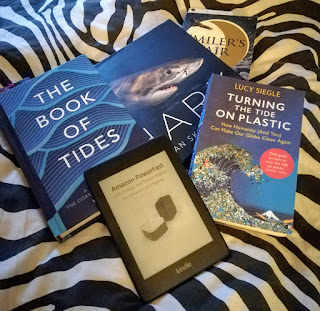Ancient Seas #3
Plesiosaurus
 |
| Photo from Wikipedia |
Kingdom: Animalia
Class: Reptilia
Conservation Status: Extinct (EX) (Unless you count Nessie.)
Found: Worldwide, number of skeletons found in the UK
Era: Jurassic
Lived: 135 million years ago
Diet: Piscivore/Carnivore
Weight: 450kg (992lbs)
Size: 3.5m (11ft)
Habitat: Ocean
The plesiosaurus is an icon marine dinosaur, as it is often how we depict the Loch Ness Monster. It has a long slender body, small head and wide flippers on its side. The term plesiosaur covers all dinosaurs with this combination of features, and they are closely related to pliosaurs (which is the dinosaur I was initially researching and getting confused about the spelling of, you can see how.) This dinosaur was discovered in 1823 by Mary Anning, a Victorian woman who collected fossils on British beaches. She is a fascinating woman who discovered a number of different dinosaur species and what a bezoar stone was. Fossilised poop if you are interested. An idicator of how awesome this woman is, she has been featured on Qi. But this a tangent which I will possibly explore in a different post.
Back to the plesiosaurus!
The plesiosaurus has a narrow and long head. The widest point is just behind its eyes, giving it a somewhat triangular shape. Their nose was also near to their eyes, which did not make for good underwater olfaction. Meaning, they couldn't smell very well underwater. This is possibly because they breathed air. They were adapted well enough for sealife, but they were slow and not as well adapted to it as other marine dinosaurs. It is even theorised that they lived akin to modern turtles, by laying their eggs on land. Overall, they were not fantastic swimmers.
Their jaws were shallow and shaped like scoops, filled with neede-like coned teeth. These teeth had fine striations on them. Their diet consisted mostly of fish, but these strong jaws could bite through molluscs. This fishy diet is probably why they were relatively light for dinosaurs. This 11ft beast only weighed twice the amount of a modern pig.
Of their 11ft length, a good portion of it goes on their neck. They had roughly 38-42 vertebrae in their necks, depending on the species. Humans have 33, so they have a few more than us. However, vertebrae number isn't always an indicator of how long a neck is, considering that giraffes only have seven. Seven very big ones, but seven nonetheless.
 |
| Artistic rendering found on New Dinosaurs |
Fun Facts
- Plesiosaurus is the most polite dinosaur. (Read it out. This joke is courtesy of Dylan.)
- Its name means "almost lizard".
- They are twice as long as a modern horse.
- It wasn't named until a year after its discovery. That honour did not go to Mary Anning, but to William Conybeare.



Comments
Post a Comment